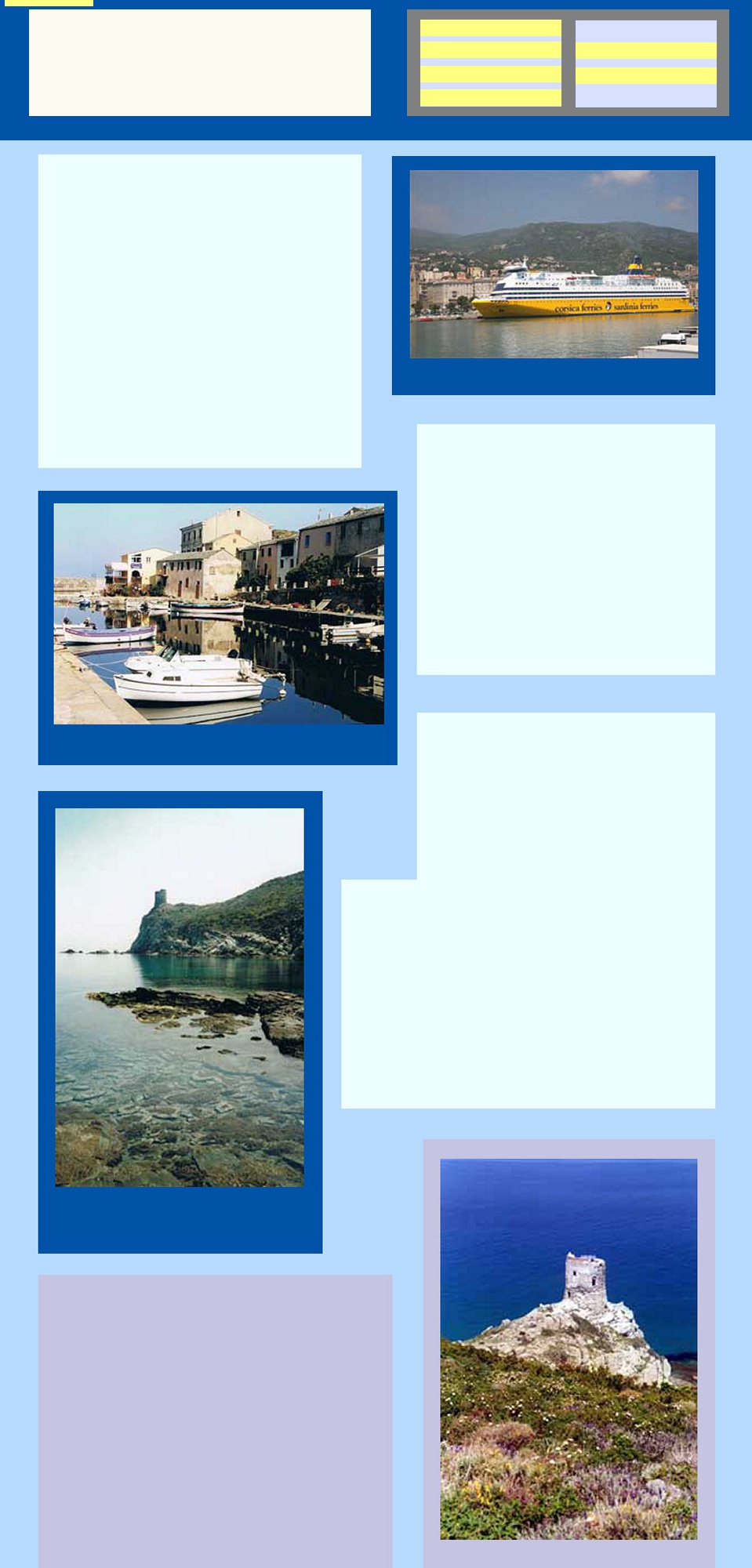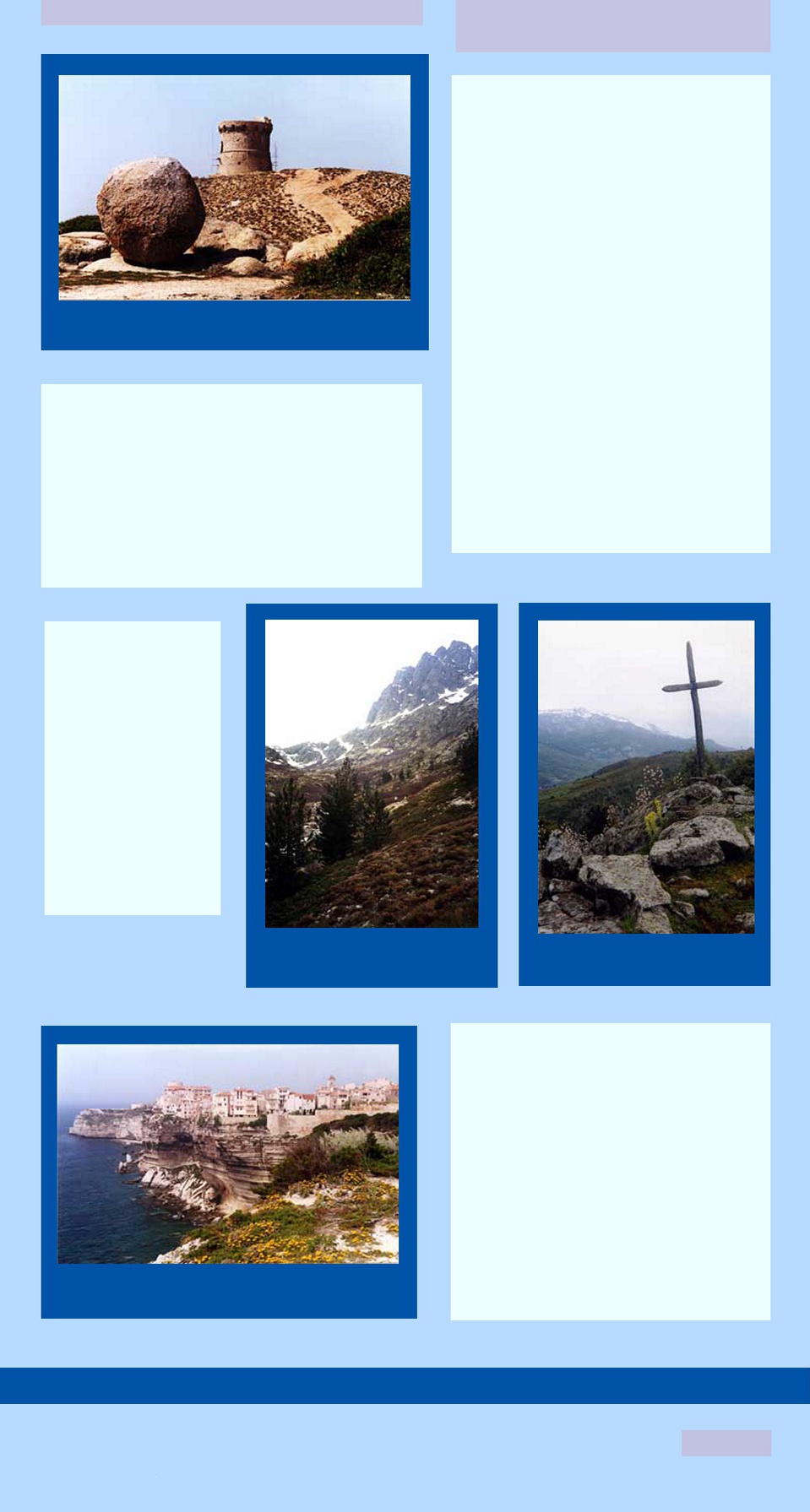


Corsica
Genoese Towers
Mountains and
About Corsica
As the regular evening service of Corsica Ferries pulls out of the
harbour of Nice, stirring music blares over the loudspeaker
system and the lights of the Promenade des Anglais gradually
fade into the distance. It's a comfortable overnight trip to Bastia
and if you're up early you can watch the Corsican coast
approaching and possibly share the experience of returning
exiles who are said to be able smell the maquis on the air 20km
from land.
For many of us, our knowledge of Corsica began (and possibly
ended) with the schoolroom teaching that Napoleon Bonaparte
was born in Corsica, left for France at an early age and then
became a military commander and Emperor. What is little
known is that he never returned and did little for the island other
than reinforce its administration as part of France. So it is
perhaps not surprising that there is little recognition of him on
the island other than rather grand statues in Bastia and
Ajaccio.
An island of 8722 sq km, 12 km from Sardinia and 90 km
from the mainland Italian coast, Corsica does not feel
particularly French. The Corsican language is still spoken
and, as you get further south the atmosphere will be
more Italian than French. There are times also when you
might even think you are driving through an Australian
landscape observing the huge river red gums introduced
in the 1860's to purify the air and assist in swamp
draining.
The high mountains of the island drop dramatically into
the ocean and driving on the narrow roads that cling to
the cliff tops and mountainsides can be terrifying. It's a
much better option to spend much of your time walking
and to drive only from one place to the next.
Walking
There is excellent walking, some of it is difficult, even
dangerous, and only for the very fit. The most challenging
route is the GR20 which runs roughly from north to south
through the central mountain range which many walkers
are surprised to discover, rises up to 2706m.
Accommodation, if not camping, is in refuges and,
although it is possible to come down to villages where
there may be comfortable beds and the opportunity to
restock provisions, you will need to be pretty self sufficient
for the 15 or more days that it will take.
There are also several other long distance walks, called the Mare a
Mare and Mare et Monti which, as their names imply, cross the
mountains generally from east to west and also climb up into the
mountains from the sea. But all over the island there are many other
tracks and trails which enable the daywalker to appreciate the best
that the island offers.
In May 2000, we began a two week visit to Corsica at the narrow
peninsula to the north called Cap Corse, staying in the idyllic small
fishing village of Centuri Port. Here you can walk by day, climbing up
through the maquis and along the coast on the route known as the
Sentier des Douaniers and by night eat in the fish restaurants around
the tiny, but very active, working harbour. By this time you will have
discovered that the most characteristic feature of the Corsican
landscape is the Genoese tower.
Genoese Towers
The Genoese towers are the most unique architectural feature in
Corsica. About 15m high, fortified and usually round in shape,
around 85 of them were constructed in the 16th century.
The towers were strategically located around the coastline, each
one visible from the next so that a signalling system could quickly
be transmitted round the coastline to warn of invasion or danger.
Around 60 still exist and from high points in the landscape you can
see 5 or 6 of them.
They were build by the Genoese who occupied Corsica for five
centuries and maintained a strong rivalry with the Pisans for
control. Attacks from the sea were common and there was a
need to protect both the military, political and commercial
interests of the island's occupiers.
The Landscape
Cap Corse has a delicate ecology which is fiercely
protected. There are exposed beaches where dune
stabilisation is underway and where protected sea
grasses called posidonia are allowed to pile up waist
high. Towering cliffs drop down into the turquoise sea
where sheltered little beaches snuggle into the base of
the cliffs. Standing on a rocky promontory is one of the
star Genoese towers, the Tour Santa Maria, which you
can climb into and look out from its parapet over the clear
shimmering sea.
In May the maquis was in full flower with a sweet, herby
smell permeating the air. Perhaps it's true that the keen
nose can pick it up from far out to sea. The maquis is a
low scrubby vegetation which is deceptively dull till you
look into it and discover the wealth of plant life. While
only small tough trees can survive in the harsh, rocky
environment, pink and white cistus, lavender, thyme,
rosemary grow together as in a carefully cultivated
garden. Sometimes daisies, cyclamens and delicate
little purple orchids add to the colour.
The maquis is a tough landscape that has harbored
bandits and independence fighters. The resistance
fighters of World War II took the name maquis as a
symbol of toughness and resilience.
In the Mountains
In the central mountains is the historic and gracious university town
of Corte. It sits at the point where the Restonica River joins the
Tavignano, Corsica's largest river which flows down to the eastern
coast of the island. There are good walks up both these valleys.
The Restonica walk is very popular, almost in the category of a
"classic" and it was not hard to see why it is so well frequented.
After driving up its gorges to the point where you must leave your
car, you follow a rocky path, through snowdrifts in May, till some
ladders climb up through rocky outcrops to reach a group of
mountain lakes.
Another walk follows one
of the long distance GR's
along the Tavignano which
up here, close to its
source, is a rushing
stream edged by rocky
cliffs and perhaps the best
maquis gardens on the
island.
Several suspension
bridges, reminiscent of
those found in New
Zealand, allow access to
the river and good places
for picnics.
Beautiful Bonifacio
At the southern tip of the island is Bonifacio, where
they speak Italian and serve excellent pasta. The
buildings along the main street of the town are almost
an extension of the chalky cliffs that plunge down to
the ocean. You look out of windows into sheer space.
Nearby to the town are an old citadel, a lighthouse
and little sandy beaches.
The harbour is busy with spruikers from the multitude
of boat companies that offer trips out to sea and
around the calanques or rocky inlets which are a
feature of the coastline. There are also some excellent
footpaths which wind through the maquis and follow
the cliff line to various points where you can scramble
down to the sea. Yellow coastal daisies lined the path
and on the return walk to Bonifacio you'll find it difficult
to stop clicking the camera.
Return to Top
A Corsica ferry at the Port of Bastia
The fishing village of Centuri Port
A Genoese Tower on Cap Corse
And yet another ...
The Restonica walk
A rustic cross in the mountains
Bonifacio perches above the chalk cliffs
And another Genoese Tower
Explore more FRANCE
Visit ITALY
Visit SPAIN/PORTUGAL
Explore on MAPS
Return to HOME PAGE